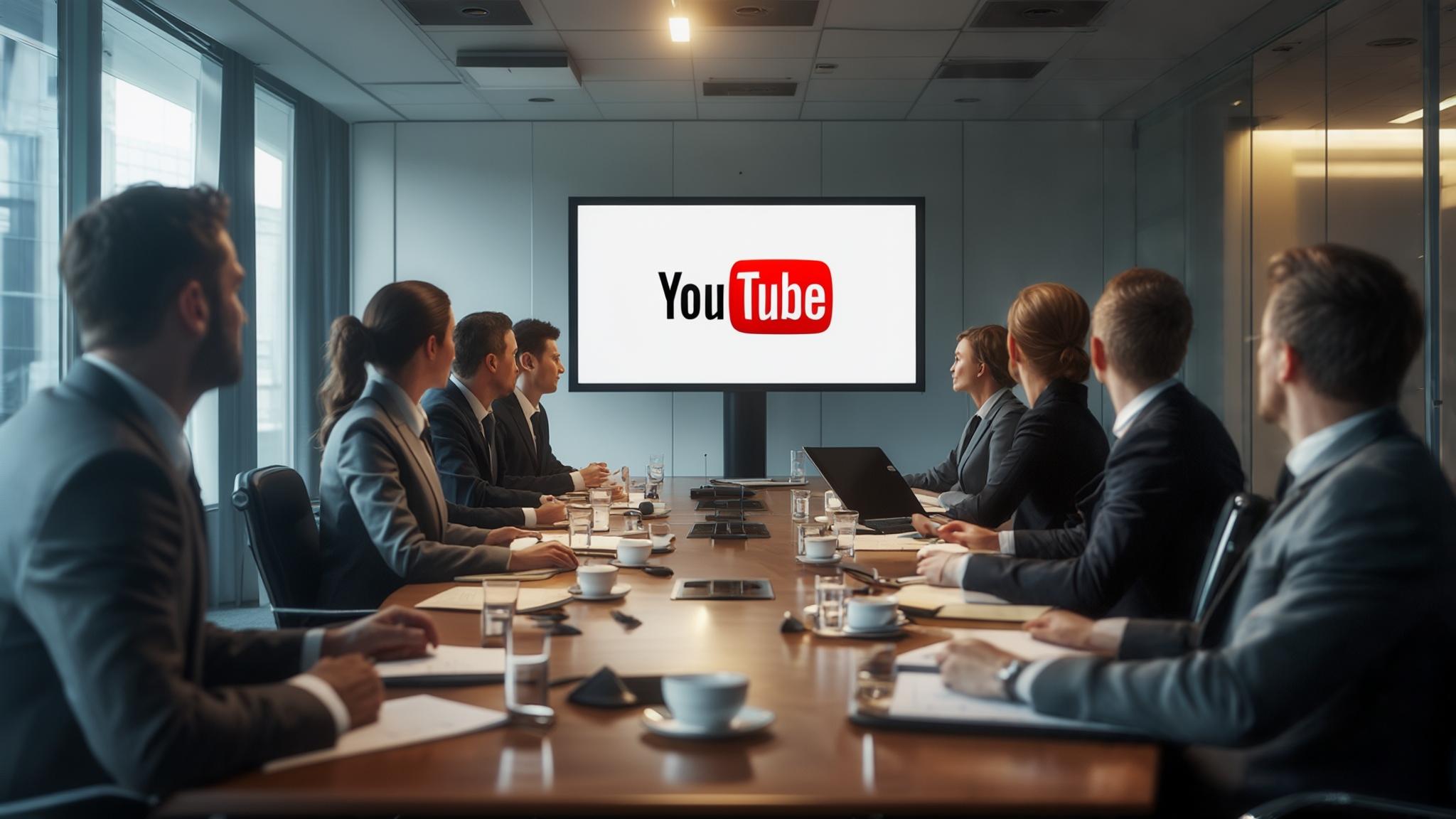Last month, I watched a client spend $50K on beautiful YouTube videos that got zero leads. It wasn’t their first rodeo either – they’d been throwing money at video content for two years with nothing to show for it. That’s when I realized most brands are doing YouTube completely backwards.
With over 2.5 billion monthly active users globally and YouTube serving as the world’s second most visited website, the opportunity is massive. But so is the competition for attention, and frankly, most brands are screwing it up by focusing on the wrong things entirely.
Table of Contents
-
Getting Your Basics Right: Building Something That Actually Works
-
Campaign Setup That Won’t Fall Apart Later
-
Content Strategy That Goes Beyond “Let’s Make Videos”
-
Measuring What Actually Matters (Not Just Vanity Metrics)
-
Making YouTube Play Nice With Your Other Marketing
-
Scaling Up Without Losing Quality
-
Real Case Studies and Solutions That Work
-
Common Problems I’ve Fixed (And How You Can Too)
-
Different Strategies for Different Business Types
-
What I’ve Learned After Years of Trial and Error
TL;DR
-
Your YouTube goals need to tie directly to business outcomes – I’ve seen too many campaigns fail because they weren’t connected to actual revenue
-
Understanding your audience goes way deeper than demographics – you need to know when they watch, what devices they use, and what they do after watching
-
Having a content framework prevents the daily “what should we post today?” panic while keeping everything consistent
-
Setting up proper analytics is what separates campaigns that actually work from those that just generate pretty reports
-
Data should inform your creative decisions, not kill them – this approach beats gut-feeling content every single time
-
YouTube’s algorithm isn’t just about keywords – engagement and keeping people watching matter way more
-
Integrating YouTube with your other marketing channels amplifies everything when done right
-
Scaling requires systems and processes, but you can’t let that kill your authenticity
-
What works for e-commerce won’t work for B2B – industry-specific strategies are crucial
-
Most problems are fixable if you know what to look for and have a systematic approach
Getting Your Basics Right: Building Something That Actually Works
Look, I’ve watched way too many brands dump money into video production without having a clue what they’re actually trying to accomplish. It’s painful to watch, honestly. The difference between campaigns that actually make you money and those that just rack up meaningless views? It all comes down to getting your foundation right from day one.
You need three things working together or you’re basically gambling: clear goals that tie to real business outcomes, actually understanding your audience (not just guessing), and having a system for what content you’re going to make. Miss any one of these and you might as well light your marketing budget on fire.
I learned this the hard way when a client celebrated hitting a million views while their sales stayed flat. Turns out, we’d built a beautiful house on quicksand. Understanding your market through comprehensive market sizing analysis helps establish realistic YouTube goals and budget allocation strategies that align with broader business objectives.
Here’s the thing – video content isn’t just another marketing channel you can wing. It’s a strategic business asset that deserves the same planning you’d give any major business decision. Without that strategic alignment, even the most creative content will flop when it comes to delivering real results.

Campaign Setup That Won’t Fall Apart Later
Building campaign architecture sounds scary, but it’s really just creating systems that make your life easier down the road. I start every campaign by figuring out how each type of video serves a specific purpose in getting someone from “never heard of you” to “take my money.”
You can’t treat a brand awareness video the same way you’d handle a product demo – they’re completely different animals with different jobs to do. The architecture is what determines whether your YouTube efforts will scale up nicely or collapse under their own weight as you grow.
This is about creating structural frameworks that connect every single piece of content to actual business outcomes while keeping things flexible enough to pivot when the data tells you to.
Getting Your Goals Actually Aligned With Business Results
Most brands completely skip this step and then wonder why their “successful” YouTube channel isn’t moving the revenue needle. I’ve literally seen companies throw parties for hitting millions of views while their actual sales stayed completely flat. Why? Because they never connected their video strategy to activities that actually make money.
Here’s what actually works (and I’ve tested this with dozens of clients):
-
Do a brutally honest audit of where you are versus where you need to be
-
Set KPIs that tie directly to revenue or leads – not just feel-good metrics
-
Map your YouTube goals to actual customer journey stages
-
Establish baseline metrics so you know if you’re improving
The audit part is crucial because it reveals the gap between your current reality and your goals. Your KPIs should tie directly to money coming in the door – not just engagement metrics that make you feel good but don’t pay the bills. This comprehensive youtube for brands case study approach ensures every video serves a measurable business purpose rather than just generating vanity metrics.
According to recent industry analysis, “YouTube still tells creators: Our algorithm doesn’t pay attention to videos, it pays attention to viewers” from Search Engine Journal, emphasizing that audience-focused strategies remain crucial for effective YouTube marketing in 2025.
I worked with a SaaS company that was celebrating 50K monthly views but getting zero trial signups. Turns out their videos were entertaining but had nothing to do with their product benefits. Once we aligned their content with actual customer pain points, trial signups jumped 300% with the same view counts.
Actually Understanding Your Audience (Not Just Guessing)
Demographics tell you who your audience is, but that’s just the surface level. What you really need to know is why they’ll actually stick around to watch your content. I spend way more time analyzing when people watch, what devices they’re using, and what they do after watching than most people think is necessary.
Get this – research shows that 70% of YouTube watch time happens on mobile devices, making mobile optimization crucial for brands targeting audiences who consume content on their phones, according to Marketing Maverick’s comprehensive YouTube analysis.
Here’s my process for actually understanding your audience:
-
Dig deep into your existing customer data and YouTube Analytics
-
Create buyer personas specifically for video content (they’re different from your regular ones)
-
Find the gaps in what your competitors are covering
-
Develop content themes that speak directly to each audience segment
Your YouTube personas need to be different from your general marketing personas because video consumption behavior is totally different. Someone might read your blog posts during work hours but watch your videos on the couch at night. You need to account for these differences.

Creating a Content System That Actually Works
Random content creation is the enemy of sustainable success on YouTube. I’ve built frameworks that eliminate those daily “what the heck should we create today?” panic sessions while making sure every video actually serves a purpose. Developing high-impact blog topics provides a foundation for video content themes that resonate with your audience and drive meaningful engagement.
Your framework needs:
-
Content pillars that align with your brand message (and stick to them)
-
Content calendars that account for seasonal stuff and industry events
-
Templates for different video types so you’re not reinventing the wheel
-
Clear approval processes so things don’t get stuck in committee hell
Content pillars are like guardrails for your creative team. They give you enough structure to stay consistent while allowing creative freedom within proven parameters. Each pillar should connect to specific business goals and audience needs.
I worked with a SaaS company that established three simple pillars: “Problem-Solving Tutorials” (addressing customer pain points), “Behind-the-Scenes” (company culture and expertise), and “Customer Win Stories” (real user transformations). This framework helped them crank out 12 videos monthly while staying on message and achieving a 40% increase in qualified leads within six months.
|
Content Pillar |
Primary Objective |
Video Types |
Success Metrics |
|---|---|---|---|
|
Educational |
Lead Generation |
Tutorials, How-tos, Explainers |
View duration, Click-through rate |
|
Brand Awareness |
Reach & Recognition |
Behind-scenes, Company culture |
Impressions, Brand mention increase |
|
Social Proof |
Conversion |
Testimonials, Case studies |
Conversion rate, Sales attribution |
|
Product Demo |
Purchase Intent |
Feature showcases, Comparisons |
Demo requests, Trial signups |
Measuring What Actually Matters (Not Just Vanity Metrics)
Measuring YouTube performance goes way beyond counting views and likes. I’ve worked with brands that went viral while their conversion rates tanked because they weren’t tracking the stuff that actually matters for business growth.
Real performance measurement means setting up systems that connect video engagement to business outcomes. You need to understand not just who’s watching, but what they’re doing after they watch. This is where most brands completely drop the ball. Implementing comprehensive GA4 audit procedures ensures your YouTube analytics integrate properly with broader business intelligence systems for accurate performance measurement.
You need analytics frameworks that track the entire customer journey from first video view to final purchase. Without this, you’re flying blind and making decisions based on vanity metrics that don’t mean anything.
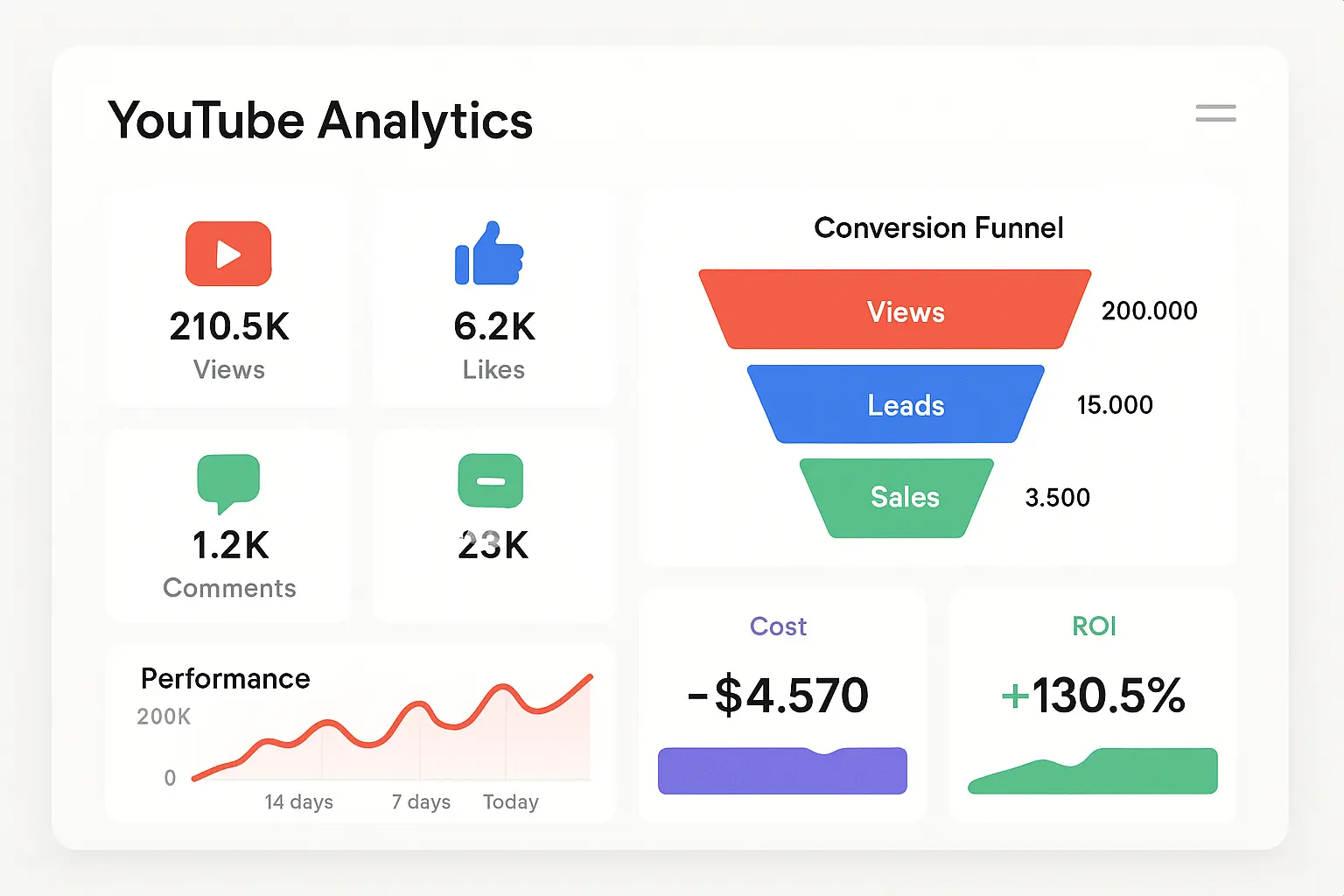
Setting Up Analytics That Actually Tell You Something Useful
Setting up proper analytics feels technical and boring, but it’s literally the difference between guessing and knowing what’s working. I connect YouTube Analytics with broader business intelligence systems to get a complete view of customer behavior.
Here’s what you need to implement:
-
YouTube Analytics integrated with Google Analytics 4 (yes, it’s a pain but do it anyway)
-
Conversion tracking for video interactions (this is where the magic happens)
-
Attribution modeling for multi-touch customer journeys
-
Custom dashboards that don’t make your stakeholders’ eyes glaze over
Integration between platforms reveals insights you’d never see looking at YouTube data alone. When you can track someone from their first video view through multiple touchpoints to final purchase, you understand the true value of your content.
I had a client who thought their tutorial videos were worthless because they had low direct conversion rates. But when we set up proper tracking, we discovered these videos were actually the first touchpoint for 60% of their highest-value customers. Without that insight, they almost killed their most valuable content.
Figuring Out Which Videos Actually Drive Revenue
Attribution modeling for YouTube gets messy because video often plays a supporting role rather than driving direct conversions. I’ve developed frameworks that account for the full customer journey while giving appropriate credit to video content. This youtube case study methodology ensures accurate ROI measurement across complex customer touchpoints and multi-channel interactions.
According to research from Marketing Maverick, 70% of YouTube users say they bought a product after seeing an ad or video review on the platform, highlighting the critical importance of proper attribution modeling for measuring true video ROI.
Your model needs:
-
Attribution windows that make sense for different campaign types
-
UTM parameter strategies for tracking video traffic
-
Cross-platform tracking for omnichannel campaigns
-
ROI calculations that account for brand lift effects
The attribution window matters more than most people realize. A brand awareness video might influence a purchase decision weeks later, and your model needs to capture these delayed conversions.
Content Strategy That Goes Beyond “Let’s Make Videos”
Content strategy isn’t just about making videos people want to watch – it’s about creating content that moves people toward specific business outcomes. I’ve seen gorgeous, engaging content that generated zero business value because it wasn’t strategically designed.
You need to balance creativity with performance optimization. The sweet spot is systematic approaches that ensure every video serves a purpose while still feeling authentic and engaging to your audience.
How I Actually Develop Creative Content That Works
Creative development without data is just expensive guesswork. I’ve built processes that use audience insights and performance data to inform creative decisions while still leaving room for innovation and authentic brand expression.
The process needs to be systematic enough for consistency but flexible enough for creative breakthroughs. You’re looking for that sweet spot between data-driven optimization and creative authenticity.

Using Data to Make Your Creative Better (Not Kill It)
Using data to drive creativity doesn’t kill innovation – it focuses it. I analyze performance patterns to understand what creative elements actually drive engagement and conversions, then use those insights to guide future content.
Here’s my strategy development process:
-
Analyze top-performing videos in your industry (including competitors)
-
Identify emotional triggers and messaging themes that drive engagement
-
Test different creative formats (tutorials, behind-scenes, testimonials)
-
Create A/B testing frameworks for thumbnails, titles, and content formats
Pattern recognition in high-performing content reveals what resonates with your specific audience. These patterns become the foundation for creative briefs that balance data insights with creative freedom.
One e-commerce client was struggling with product videos that felt too salesy. By analyzing their best-performing content, we discovered their audience responded better to “problem-solution” narratives than direct product pitches. Shifting to this approach increased their video-driven sales by 180%.
Making Your Brand Part of the Story (Without Being Annoying)
Heavy-handed brand integration kills video performance faster than anything else. I’ve developed methods for weaving brand messaging naturally into content without making viewers feel like they’re watching a 10 -minute commercial.
Effective brand integration requires:
-
Subtle branding guidelines for different content types
-
Natural product integration strategies that don’t feel forced
-
Compelling call-to-action frameworks that feel helpful, not pushy
-
Testing different brand mention frequencies and placements
The key is making your brand presence enhance the value you’re providing rather than interrupt it. When done right, viewers appreciate the brand connection because it makes their experience better.
Recent platform updates show that “YouTube Shorts is now averaging over 70 billion daily views” according to Search Engine Journal, making short-form content integration a critical component of modern brand strategies.
Making YouTube’s Algorithm Work For You
YouTube’s algorithm rewards content that keeps people on the platform longer. I optimize for the signals that matter most: click-through rates, watch time, engagement, and session duration.
Understanding how the algorithm works helps you create content that gets discovered and recommended. But here’s the thing – optimization should enhance your content strategy, not drive it. You still need to prioritize value for your audience above everything else.

Getting Found When People Are Actually Looking
YouTube SEO works differently from traditional SEO, but understanding search intent and optimizing for discovery still matters. I research what your audience is actually searching for, then optimize content to match those queries.
The optimization process includes:
-
Keyword research using YouTube’s search suggest and Google Trends
-
Optimizing titles, descriptions, and tags for search visibility
-
Creating thumbnails that improve click-through rates (this is huge)
-
Implementing closed captions and transcripts for accessibility and SEO
Keyword research for YouTube reveals the actual questions your audience is asking and the language they use. This insight informs not just your metadata but your actual content topics and structure.
Research from Growth Models shows that YouTube has over 2.7 billion active users monthly, making it the second most visited website globally, highlighting the massive opportunity for brands that master discovery optimization.
Keeping People Watching (So YouTube Shows Your Stuff to More People)
Engagement signals tell YouTube whether your content is worth recommending to more people. I design content specifically to maximize these signals without sacrificing the authentic value that keeps audiences coming back.
Signal enhancement strategies include:
-
Designing hooks and retention strategies for the first 15 seconds (this is make-or-break time)
-
Implementing interactive elements like polls, cards, and end screens
-
Creating community engagement strategies through comments and responses
-
Developing series and playlist strategies to increase session duration
The first 15 seconds determine whether someone stays or leaves. I spend way more time crafting openings that immediately deliver on the promise made in the title and thumbnail than most people think is reasonable.
An e-commerce brand I worked with increased their average view duration by 65% by implementing a “problem-solution-proof” hook structure. Instead of starting with their logo and boring intro music, they immediately presented a customer pain point, teased the solution, and showed a quick before/after result. The algorithm loved it.
Making YouTube Play Nice With Your Other Marketing
YouTube doesn’t exist in a vacuum, an d treating it like a standalone channel limits its potential impact. I integrate YouTube content with email marketing, social media, paid advertising, and content marketing to create cohesive customer experiences.
Integration amplifies the impact of every piece of content by extending its reach and reinforcing its message across multiple touchpoints. When done right, your YouTube content makes every other marketing channel more valuable. Calculating the true marketing ROI across integrated campaigns helps demonstrate the compounding value of multi-channel YouTube strategies.
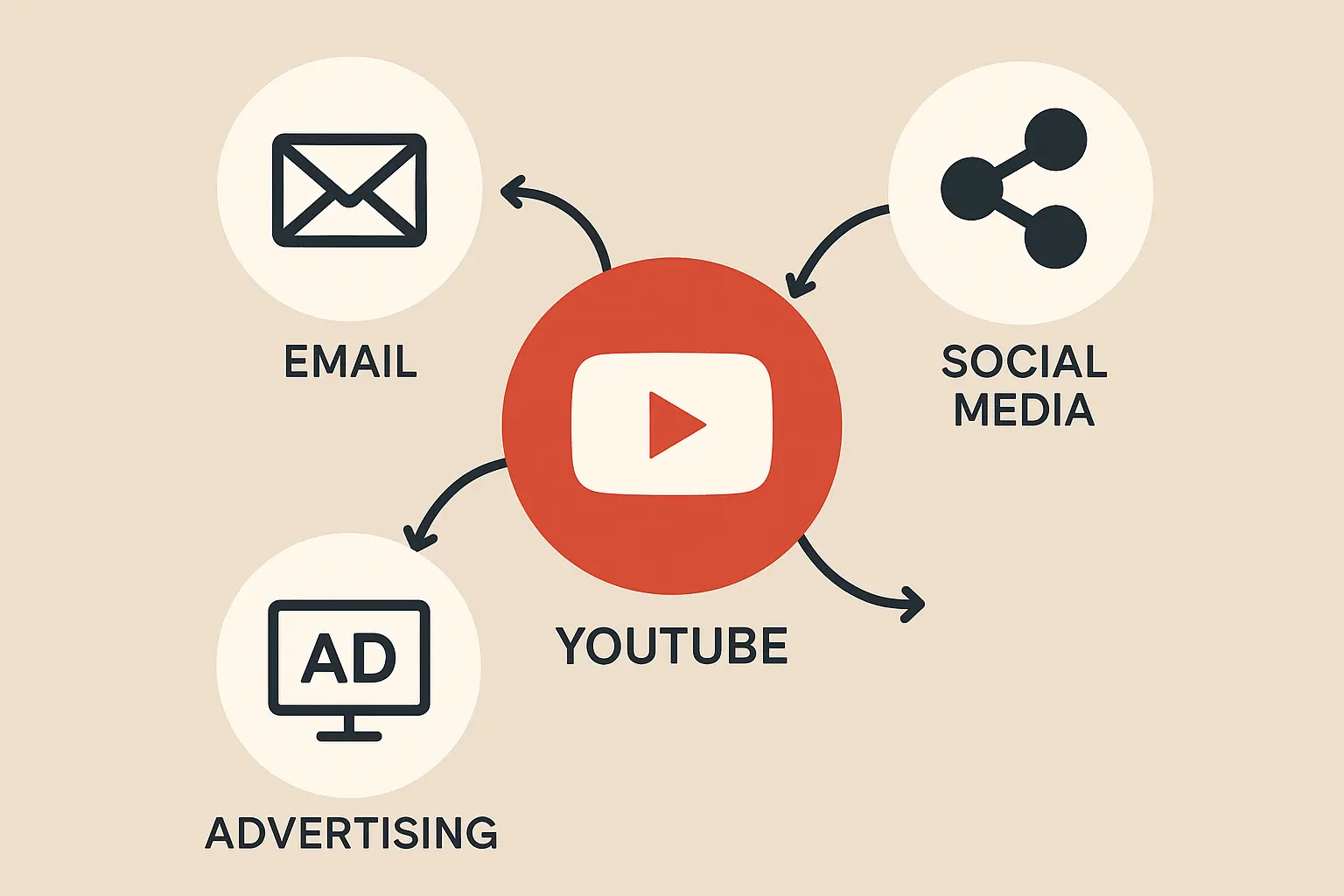
Getting More Mileage Out of Every Video You Make
Creating content exclusively for YouTube wastes the potential value of your video assets. I develop adaptation strategies that transform YouTube content into blog posts, social media content, email campaigns, and sales materials.
The adaptation process involves:
-
Content adaptation frameworks for different platforms
-
Cross-promotional strategies between YouTube and other channels
-
Consistent branding across all touchpoints
-
Automated content distribution workflows (because manual is not scalable)
Each platform has different consumption patterns and technical requirements. Your adaptation strategy needs to optimize for these differences while maintaining consistent messaging and brand voice.
Coordinating Everything So It Actually Works Together
Campaign orchestration prevents your marketing channels from working against each other. I coordinate YouTube content launches with email campaigns, social media pushes, and paid advertising to create momentum that no single channel could achieve alone.
Orchestration requires:
-
Aligning YouTube content calendars with broader campaign launches
-
Creating consistent messaging hierarchies across all channels
-
Implementing cross-channel attribution tracking
-
Developing unified reporting dashboards for campaign performance
Timing coordination amplifies impact exponentially. When your YouTube video launches simultaneously with supporting content across other channels, you create a unified brand experience that reinforces your message.
Scaling Up Without Losing Quality
Scaling YouTube operations without losing quality is where most brands mess up. I’ve built workflows that enable consistent output while maintaining the strategic focus and brand authenticity that made your initial content successful.
The challenge is keeping the personal touch and strategic thinking that made your initial content work while producing content at scale. Automation should enhance human creativity, not replace it.
Building Systems That Don’t Kill Your Creativity
Workflow optimization eliminates the chaos that kills productivity and quality in content production. I create standardized processes that maintain quality standards while enabling teams to produce content efficiently at scale.
Optimized workflows include:
-
Standardized production templates and checklists (boring but essential)
-
Project management systems for content workflows
-
Quality assurance protocols for all video content
-
Automated publishing and promotion schedules
Templates and checklists ensure consistency without killing creativity. They provide structure for the technical and strategic elements while leaving room for creative expression within proven frameworks.
My YouTube Content Production Checklist:
-
Keyword research completed and target keywords identified
-
Script reviewed and approved by stakeholders
-
Thumbnail designed and A/B test variants created
-
Video description optimized with relevant keywords
-
End screens and cards configured for engagement
-
Closed captions uploaded and reviewed
-
Cross-platform promotion schedule planned
-
Analytics tracking parameters implemented
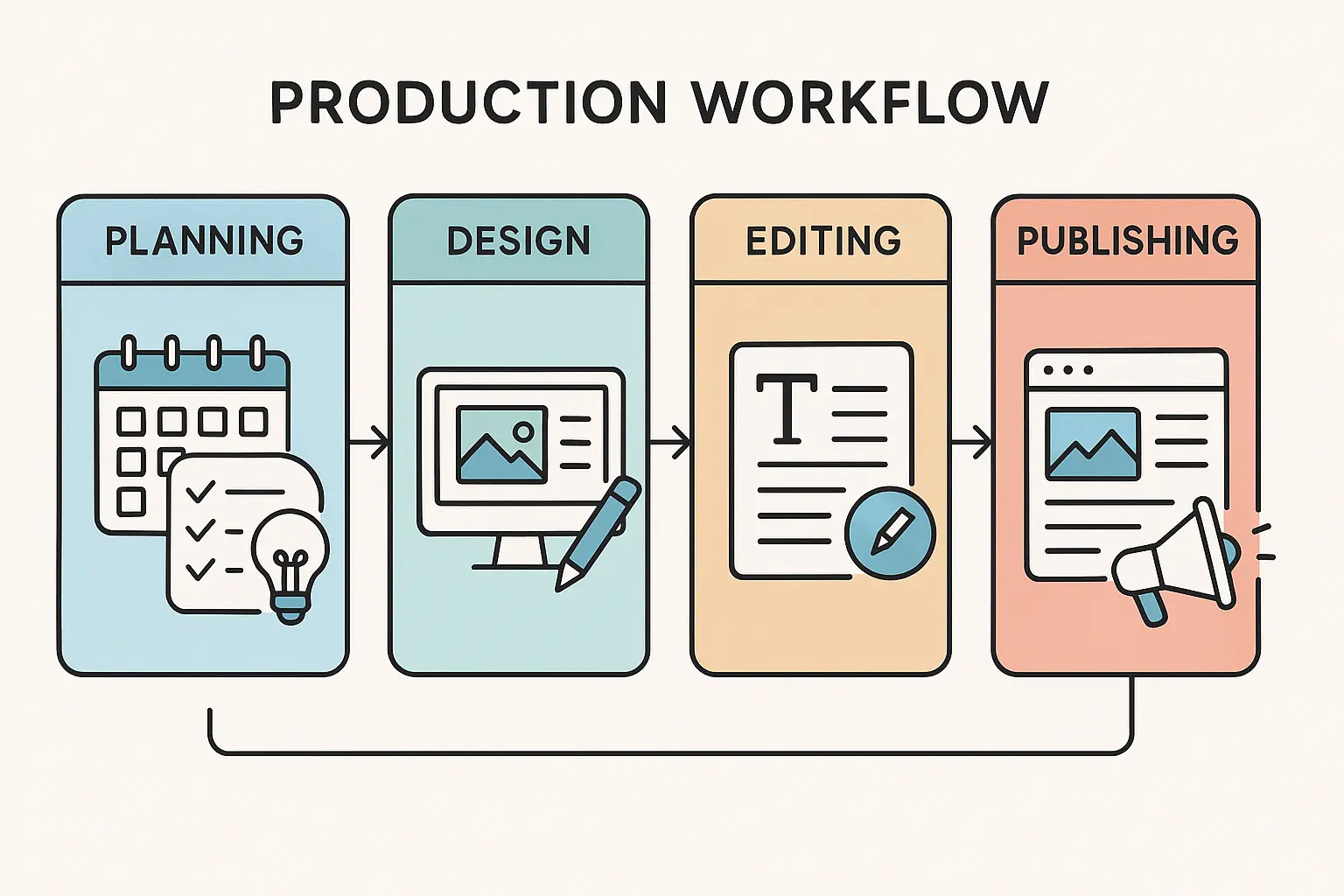
Real Case Studies and Solutions That Work
Real case studies reveal the gap between theory and practice in YouTube marketing. I analyze successful campaigns to understand not just what worked, but why it worked and how those insights can be applied to different business contexts. This youtube for brands case study solution methodology transforms abstract strategies into actionable frameworks that deliver measurable results.
Case study analysis goes beyond surface-level observations to understand the strategic decisions, tactical implementations, and measurement frameworks that drove success. This deeper analysis enables replication and adaptation rather than just inspiration.
What I’ve Learned From Campaigns That Actually Worked
Pattern recognition in successful campaigns reveals universal principles that work across different industries. I look for the strategic and tactical elements that consistently drive results across different brands and contexts.
The analysis focuses on identifying scalable, replicable elements rather than one-off successes that can’t be systematically reproduced. These patterns become the foundation for strategic frameworks that can be adapted to different business needs.
Why Different Industries Need Completely Different Approaches
Generic YouTube strategies fail because they ignore industry-specific nuances. I’ve developed different approaches for B2B companies, e-commerce brands, service providers, and SaaS businesses because each faces unique challenges and opportunities.
B2B audiences consume content differently than B2C audiences. They’re looking for expertise, credibility, and solutions to specific business problems. Your content strategy needs to reflect these different motivations and decision-making processes.
|
Industry |
Primary Content Focus |
Key Metrics |
Typical Video Length |
Best Performing Formats |
|---|---|---|---|---|
|
B2B SaaS |
Educational/Problem-solving |
Lead quality, Demo requests |
8-12 minutes |
Tutorials, Case studies |
|
E-commerce |
Product demonstration |
Conversion rate, ROAS |
3-5 minutes |
Unboxings, Reviews |
|
Professional Services |
Thought leadership |
Consultation bookings |
10-15 minutes |
Expert interviews, How-tos |
|
Healthcare |
Educational/Trust-building |
Engagement, Brand trust |
5-8 minutes |
Patient stories, Educational |
How to Actually Apply What Works to Your Business
Implementation frameworks bridge the gap between case study insights and practical application. I create step-by-step processes that enable teams to apply successful strategies while adapting them to their specific business context and resources.
Framework development involves:
-
Documenting successful campaign elements and decision points
-
Creating implementation checklists for different campaign types
-
Developing testing protocols for new strategy implementations
-
Building knowledge repositories for continuous learning and improvement
Documentation captures the strategic thinking behind successful campaigns, not just the tactical execution. This enables teams to understand why certain decisions were made and how to adapt them to different circumstances.
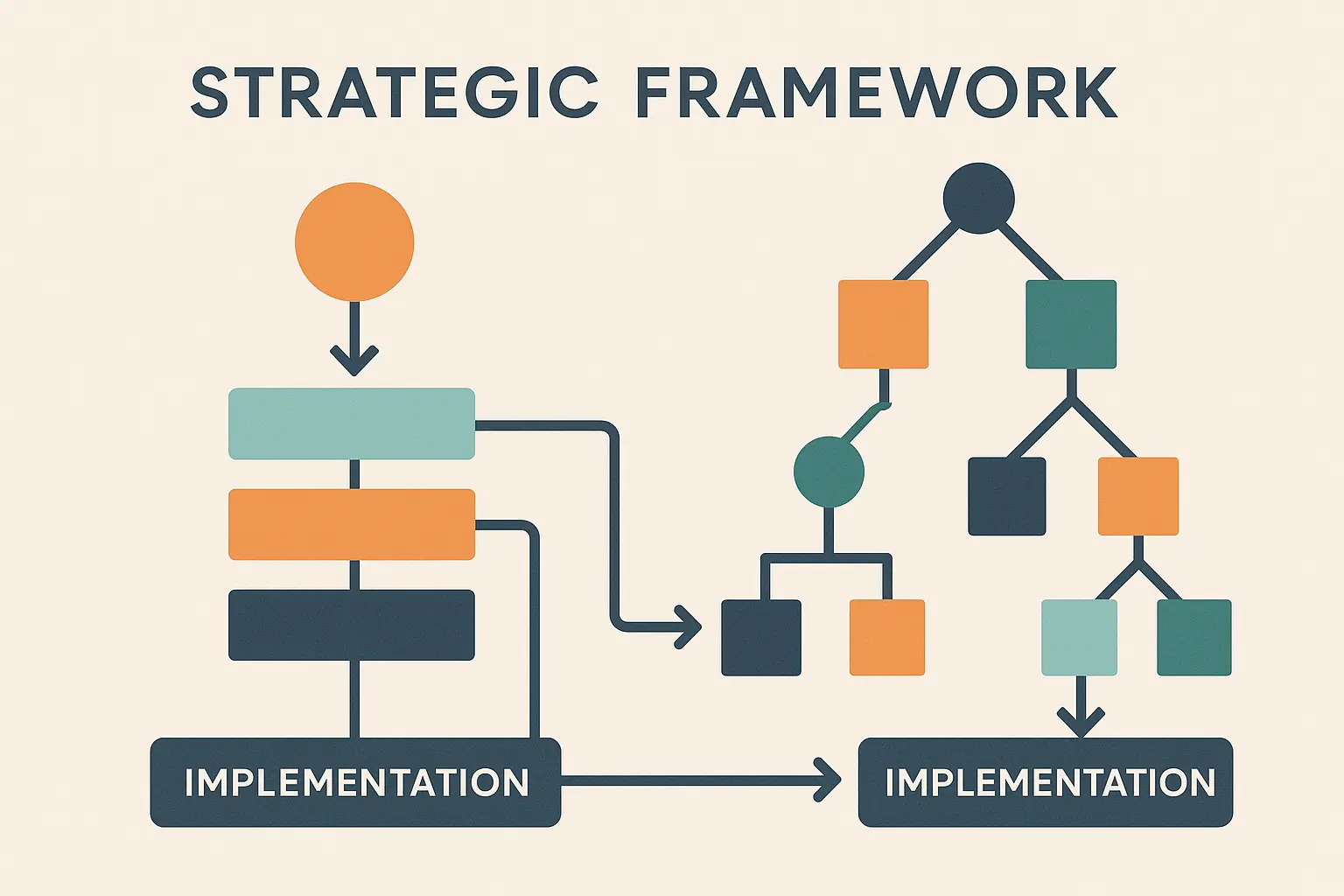
Common Problems I’ve Fixed (And How You Can Too)
Every YouTube campaign faces predictable challenges, but most brands treat each problem like it’s completely unique instead of applying systematic approaches to fix them. I’ve developed frameworks for quickly identifying and solving the most common performance issues that kill campaigns.
Problem-solving becomes way more efficient when you understand the typical failure patterns and have proven solutions ready to go. This prevents small issues from snowballing into campaign-killing disasters.
When Your Videos Aren’t Getting Engagement
Low engagement usually comes from one of four things: crappy targeting, weak opening hooks, setting wrong expectations, or technical problems. I use diagnostic frameworks to quickly figure out which one is screwing things up.
Here’s my diagnostic process:
-
Analyze audience retention graphs to see exactly where people bail out
-
Compare thumbnail click-through rates against industry benchmarks
-
Check if your content actually matches what people are searching for
-
Test different video lengths and formats for your specific audience
Retention graphs tell you the real story of viewer engagement better than any other metric. They show exactly when and why people stop watching, which reveals whether the problem is with your hook, content structure, or audience targeting.
My Low Engagement Diagnostic Checklist:
-
Check audience retention graph for major drop-off points
-
Compare CTR to industry benchmarks (2-10% is typical)
-
Verify target keywords match actual search intent
-
Review thumbnail and title alignment with content
-
Analyze comment sentiment and feedback themes
-
Test different video opening strategies
-
Evaluate content value delivery timing
When People Watch But Don’t Buy Anything
High engagement without conversions means there’s a disconnect between your content and your business goals. I’ve developed systematic approaches for bridging this gap and turning viewers into customers or leads. Implementing proper ROAS calculation methods helps identify which video content drives the highest return and optimize conversion paths accordingly.
Optimization solutions include:
-
Clear, compelling calls-to-action at the right moments in your videos
-
Dedicated landing pages that match your video content themes
-
Retargeting campaigns for video viewers who didn’t convert
-
Testing different lead magnets and incentive structures
Call-to-action placement and timing makes a huge difference in conversion rates. The CTA needs to feel natural within the content flow while being compelling enough to get people to act immediately.
A consulting firm I worked with was getting 100K+ views but zero consultation bookings. We discovered their CTA was buried at the end of 15-minute videos when most viewers had already left. By moving a soft CTA to the 3-minute mark (where retention was still high) and offering a free diagnostic checklist, they increased consultation requests by 340% with the same view counts.
Different Strategies for Different Business Types
Different business types need fundamentally different YouTube approaches. I’ve developed specialized frameworks for B2B companies, e-commerce brands, and service-based businesses because each has unique objectives and success metrics.
What Works for B2B Companies
B2B YouTube success requires different metrics and strategies than B2C campaigns. I focus on lead quality over quantity and design content that supports longer sales cycles with multiple touchpoints.
The B2B framework includes:
-
Educational content series that address specific industry pain points
-
Case study video formats that showcase measurable client results
-
LinkedIn integration strategies for professional audience targeting
-
Nurture sequences that move viewers through the B2B sales funnel
Educational content builds trust and positions your brand as a thought leader before prospects are ready to buy. This works way better than direct sales content for B2B audiences who need to build confidence before making purchasing decisions.

E-commerce Strategies That Actually Drive Sales
E-commerce YouTube strategies need to balance product demonstration with entertainment value. I’ve developed frameworks that showcase products naturally while providing genuine value to viewers.
E-commerce strategies include:
-
Product demonstration videos with clear purchase pathways
-
YouTube Shopping features and product showcases
-
Unboxing and review content strategies
-
Dynamic retargeting campaigns based on video engagement
Product demonstrations work best when they solve specific problems or show unexpected uses. The goal is helping viewers visualize how the product fits into their lives rather than just listing features.
Service-Based Businesses: Proving Your Worth Before They Hire You
Service-based businesses need to prove their expertise before prospects will consider hiring them. I develop content strategies that demonstrate knowledge and results while building personal connections with potential clients.
Service business strategies include:
-
Thought leadership content that demonstrates expertise
-
Client success story formats that build credibility
-
Consultation booking systems integrated with video content
-
Educational series that pre-qualify prospects
Client success stories provide social proof while demonstrating your ability to deliver results. They work better than testimonials because they show the process and outcomes rather than just opinions.
Working with The Marketing Agency can help you implement these YouTube strategies effectively while integrating them with your broader digital marketing efforts. Their data-driven approach ensures your video content supports measurable business outcomes rather than just generating vanity metrics. If you’re ready to turn your YouTube channel into a revenue-generating asset, their team can help you build the strategic foundation and measurement systems that drive real results.

What I’ve Learned After Years of Trial and Error
YouTube marketing isn’t getting easier, but the opportunities for brands willing to approach it strategically keep growing. The difference between success and failure comes down to treating video content as a strategic business asset rather than just another marketing channel.
The frameworks I’ve outlined here work because they’re based on systematic analysis of what actually drives business results, not just engagement metrics that look good in reports. When you align your YouTube strategy with clear business objectives, implement proper measurement systems, and optimize based on real performance data, video marketing becomes a predictable revenue driver rather than an expensive experiment.
Look, sustainable YouTube success takes patience and consistency. The brands getting the best results are those that commit to long-term strategic approaches rather than chasing viral moments or algorithm hacks that provide temporary boosts but no lasting value.
Here’s the bottom line – YouTube marketing success requires systematic approaches that balance creativity with data-driven optimization. The brands that achieve measurable results treat video content as a strategic business asset rather than just another marketing channel, implementing comprehensive frameworks for content creation, performance measurement, and continuous optimization.


